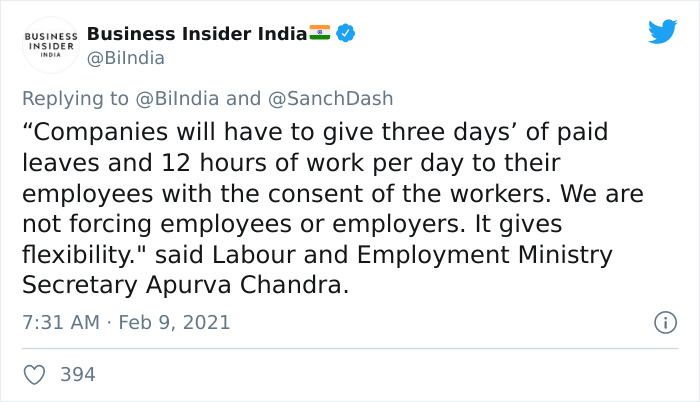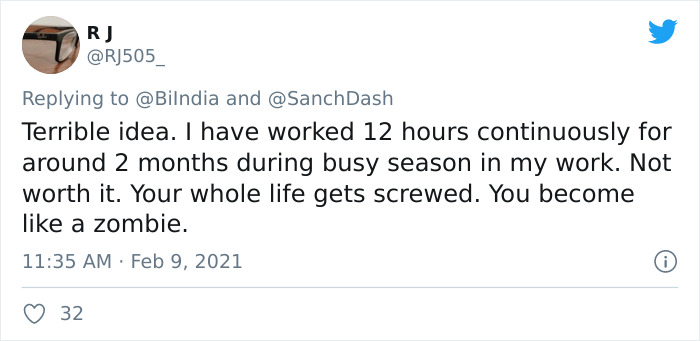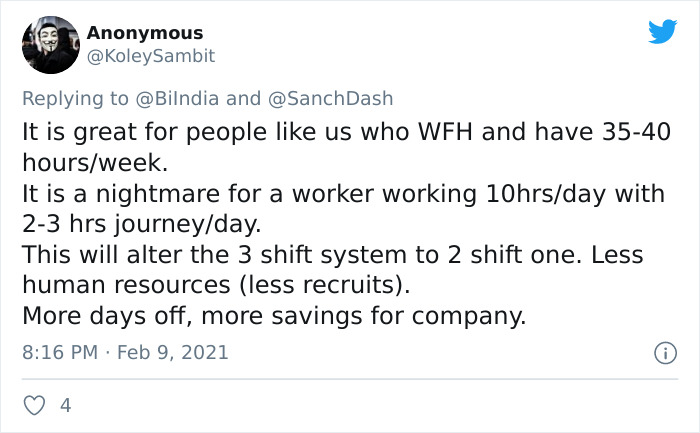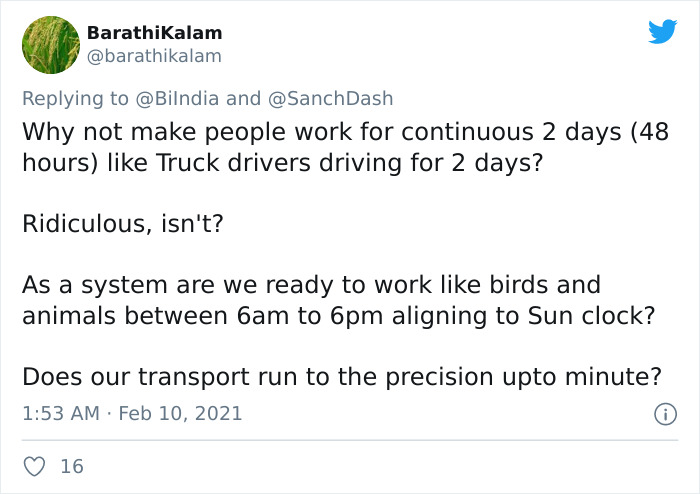
People Are Saying India’s Idea Of 4-Day Work Week Is ‘Rubbish’ As They Expect People To Work 12 Hours Per Day
In 2019, Microsoft Japan shifted to a 4-day work week and noticed a 40% increase in productivity. In 2020, Unilever New Zealand started a year-long experiment on whether a four-day work week should be extended to its 155,000 employees across the globe as well.
Now, India is considering the same. Kinda.
As the government finalizes the rules for the new labor codes, the Labor Ministry began talking about giving flexibility to companies to have four working days instead of five or six.
Image credits: BiIndia
The new labor codes could provide companies with the flexibility of four working days in a week, even as the working hours limit of 48 hours for a week will remain “sacrosanct”, Labor and Employment Secretary Apurva Chandra said.
This implies that there would be longer working hours if the working days were reduced. For example, a 4-working-day week would have to meet the 48-hour weekly work hours, resulting in daily shifts of 12 hours, which will correspondingly reduce if there is a five-day or six-day working week. And the Internet is having mixed feelings about this.
The Labor Secretary stated that having a reduced number of working days does not mean a cut in paid holidays.
The rulemaking process is already underway and some think it could be completed within a week.
Image credits: BiIndia
These changes will be a part of the new labor codes, whose draft rules are being formulated by the government. Employees should also get free medical check-ups through the Employees State Insurance Corporation, according to some reports.
Of course, a country has to do much more than enact laws. It has to enforce them.
In 2019, the Indian government released a report which painted a harrowing picture of the condition of workers in the country, with most earning less than half of the minimum accepted norms, 71% not having any written job contract, 54% not getting paid leave and over 57% in rural areas and nearly 80% in urban areas working much beyond the 48-hour week.
Image credits: BiIndia
Image credits: BiIndia
Data from jobs marketplace ZipRecruiter shows that in 2020, the share of company job postings offering four-day work weeks was 69 for every 10,000 job postings. “It’s a tiny number to be sure, but it’s up from 40 in 2019. Between 2015 and 2018, the share was fewer than 18 in 10,000 postings each year,” Quartz’s Michelle Cheng wrote.
That increase might suggest that companies are trying to cut costs during challenging times. But the new interest in shortened workweeks may also reflect a dawning understanding that people can be more productive outside the regular work week.
“Companies may be realizing that they can get five days’ worth of work done in four,” Julia Pollak, a labor economist at ZipRecruiter, explained.
Image credits: BiIndia
Image credits: BiIndia
And it’s not like only giants like industry giants like Microsoft Japan can allow themselves to work shorter weeks.
For example, the staff at Australian nail polish brand Kester Black all work a four-day week, with founder Anna Ross previously explaining that it’s important that employees have a say in any potential operational changes of this nature.
Kathryn Blackham, chief executive of Versa, once told the ABC that adopting a four-day work week at the digital agency has led to a 30-40% increase in revenue and a trebling of profits over a period of 12 months.
Image credits: BiIndia
Image credits: BiIndia
However, as Cheng noted, while the percent increase in companies adopting four-day weeks is large, the absolute number of companies going this way is still tiny. Plus, shortened workweeks remain impractical for more hands-on industries like construction and personal care, where hours-in usually correlates with productivity-out.
Image credits: Israel Andrade
People are not sure if this is a good idea
Image credits: abhichanger
Image credits: abhichanger
Image credits: Sridhar1415
Image credits: Sridhar1415
Image credits: RJ505_
Image credits: KoleySambit
Image credits: saudev001
Image credits: olia danilevich
Image credits: bhadvish
Image credits: rishdsh
Image credits: SHAGUNBHASIN1
Image credits: imNitin_
Image credits: barathikalam
Image credits: ananyaishu
Image credits: Soreiyofleix
Image credits: Product School
Image credits: deepakmrd27
Image credits: PragathiY
Image credits: rraoind
Image credits: smartmadhavarao
Image credits: Debojit1986
Image credits: Thought Catalog
Image credits: ForeverKrishnas
However, not everyone hates the plan
Image credits: roughneckpowar
Image credits: DeepakS91178039
Image credits: Jeetenderku
Image credits: captorofimages
Ridiculous idea. People don't get one extra day off, because they need that day to recover from the long working days. Because people are so tired they will make more mistakes, productivity will go down but the number of accidents will go up. If you really want to give people more time off, just decrease the number of working hours. In the Netherlands you legally can't work more than 9 hours a day, 45 hours per week and 2080 hours per year. On average most people work about 37,5 hours per week.
my schedule is two on two off basically so I can work two days, crash one and still have a day off.
Load More Replies...The longer hours is a tough sell, but I worked at a place where we had four 10-hour days. It was tough at first, but knowing that you get a three-day weekend every week (and sometimes four days on holidays!) helped us push through.
I think 10 hours is doable. 12 is just a little too far.
Load More Replies...Ah, so corporations own the government in India too? Yeah, this will start as an "option" for about 6-12 months and then the executives will all say "we need to do this too so we can stay competitive and you can keep your jobs!" Same bullshit every time. "Oh, it's just an idea we want to try" and then "Do it or lose your job."
Ridiculous idea. People don't get one extra day off, because they need that day to recover from the long working days. Because people are so tired they will make more mistakes, productivity will go down but the number of accidents will go up. If you really want to give people more time off, just decrease the number of working hours. In the Netherlands you legally can't work more than 9 hours a day, 45 hours per week and 2080 hours per year. On average most people work about 37,5 hours per week.
my schedule is two on two off basically so I can work two days, crash one and still have a day off.
Load More Replies...The longer hours is a tough sell, but I worked at a place where we had four 10-hour days. It was tough at first, but knowing that you get a three-day weekend every week (and sometimes four days on holidays!) helped us push through.
I think 10 hours is doable. 12 is just a little too far.
Load More Replies...Ah, so corporations own the government in India too? Yeah, this will start as an "option" for about 6-12 months and then the executives will all say "we need to do this too so we can stay competitive and you can keep your jobs!" Same bullshit every time. "Oh, it's just an idea we want to try" and then "Do it or lose your job."

 Dark Mode
Dark Mode 

 No fees, cancel anytime
No fees, cancel anytime 






















































































65
55